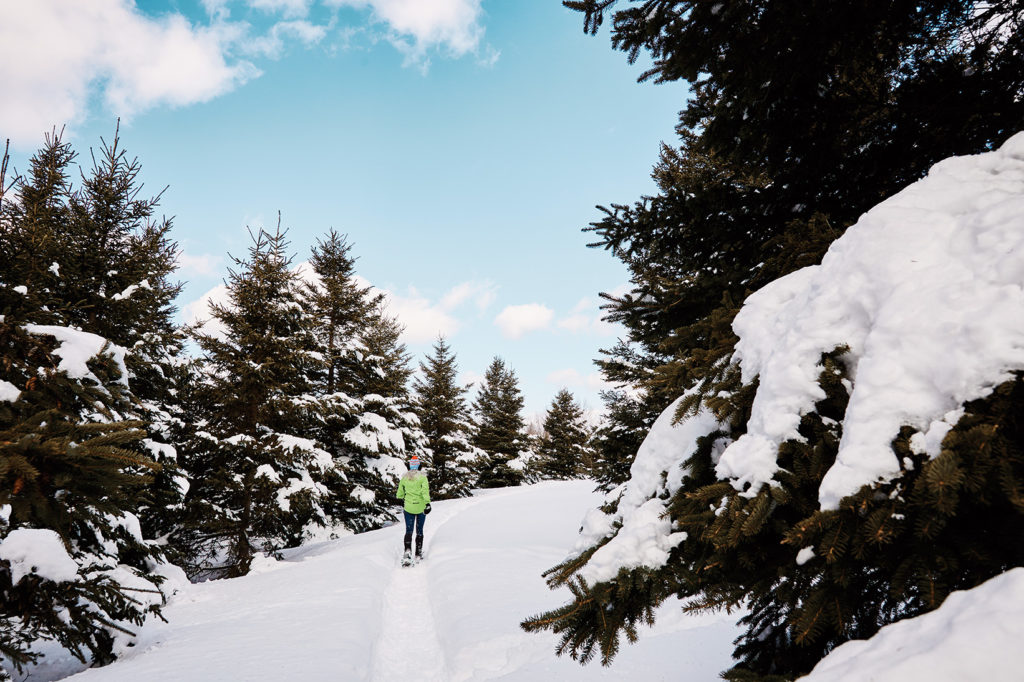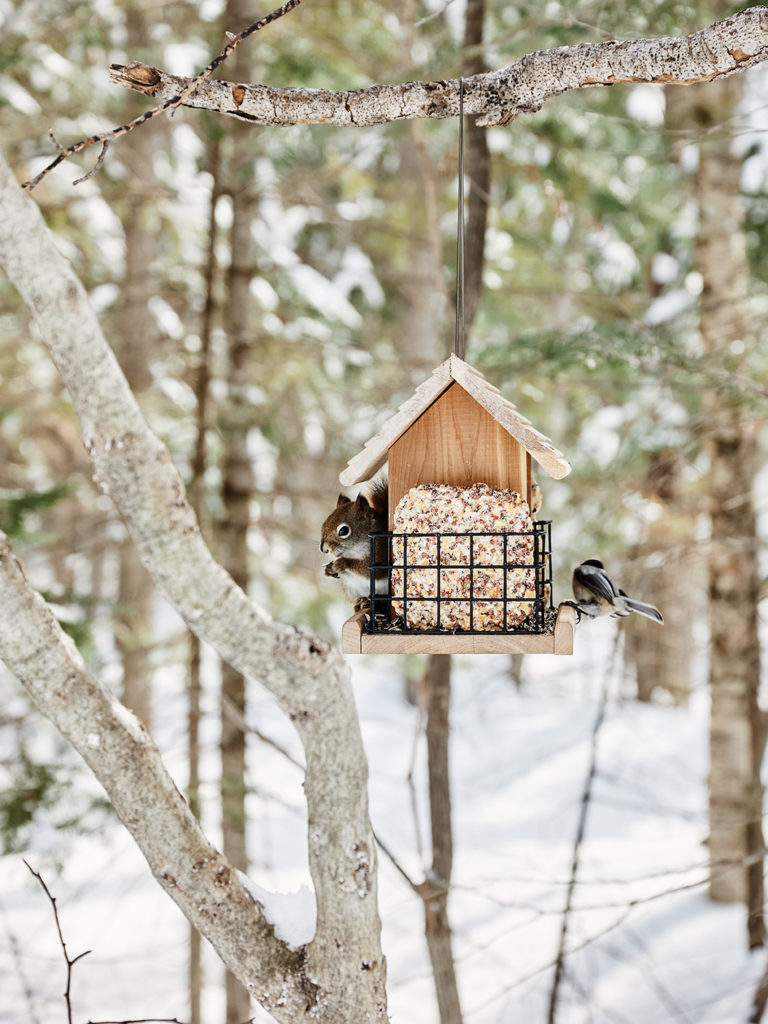A Master and His Apprentice Keep the Art of Snowshoe Making Alive
Follow along to the snowiest corner of Aroostook County for a lesson in walking on clouds.

A Master and His Apprentice Keep the Art of Snowshoe Making Alive
Follow along to the snowiest corner of Aroostook County for a lesson in walking on clouds.
by Sandy Lang
Photography by Peter Frank Edwards
Issue: November // December 2022
The snow gets deep up here in Fort Kent. On a visit in early March to northern Maine’s Aroostook County, while the Can-Am mushers are still in town after the annual international sled dog race, local residents shovel snow from rooftops before the next flurries hit. A few miles from downtown and from the frozen St. John River, heaps of snow cover the yard outside of the rambling workshop and shed. This is where Brian Theriault keeps the snowshoe-making materials and tools that he and his family have collected since he was a kid in the 1960s.
Another snowstorm is forecast for the weekend. But this afternoon, Theriault is spending a couple of hours with 13-year-old Bret Babin, whose family lives nearby. Babin notes it’s his fifth visit so far to the workshop, where he learns from the master snowshoe maker about the history of snowshoes—and how to craft them of freshly cut wood and rawhide using traditional methods. It’s an apprenticeship made possible through an award from the Maine Arts Commission.
On this day, the two have brought several pairs of snowshoes to a nearby snowbank to examine them in the bright winter sunshine. Looking at them propped in the snow, Theriault talks about their lasting usefulness. “Remember when they found a 6,000-year-old snowshoe in a melting glacier in the Alps?” he asks, recalling a story reported from Italy several years ago.


In Maine it was common for families to make and use snowshoes well into the last century, and the Theriaults adapted their designs from snowshoes made in the St. John Valley by First Nations people and early French Acadian settlers—both cultures that the family descended from. Theriault notes it was snowmobiles that led to a decline in snowshoeing as the favored way of getting around when a blanket of snow covers roadways and trails. (But he still champions snowshoes as the better option: no gas is needed, and you can get to places snowmobiles can’t.)
Babin, who says he’d like to be a game warden one day, attaches a pair of snowshoes to his boots with leather straps and ventures across the untrammeled snow of the sideyard, each footfall breaking a trail. He goes slowly at first and works up to a trot, making a few loops and big figure-eights. Then, his face flushed from the exercise and chilly air, he calls over his shoulder, “It feels like I’m floating.”
That’s good. Theriault, who’s been watching, explains that a well-designed snowshoe should have “excellent flotation” on snow and shouldn’t become weighted down with clumps of snow on the webbing. “You want the snow to go right through,” he says. That way, “snowshoeing is like walking on a cloud. It’s a great feeling.”


Theriault, 65, is the third of 11 children and learned the craft more than 50 years ago working alongside his father, Edmond Theriault, who celebrated his 99th birthday this year and now lives in Scarborough. “My father and I still talk about snowshoes all the time,” says the younger Theriault. Wanting to help preserve the know-how of snowshoe making, the father and son have self-published several highly detailed books and videos about the process, including an illustrated, 278-page volume titled Brown Ash Snowshoes: A North American Tradition that they sell online.
Green, Not Steam
First, find a tree to harvest. That’s the start of snowshoe craft-ing, according to Theriault. He surmises that only about one in a hundred brown ash or white ash trees has the right characteristics: strength, a straight trunk, and the flexibility to be bent into the wooden frames of the shoes. “A good-bending tree is hard to find,” he says, “and it needs to be green wood. We don’t use steam, because if you use green wood, you can bend it.”
This is done by bending strips of the freshly milled wood around a mold and using clamps to hold the bent wood in place. Theriault shows us around the workshop and tools the business has used through the years. There are vices and hammers, drills and metal spikes, and a worktable made from a modified sewing table. Lately he’s been teaching Babin to stretch the rawhide—Theriault prefers rawhide from cattle rather than deer, moose, or beaver. It’s a thicker rawhide that, once stretched, he says is more durable for lacing and knotting around the snowshoe frames and for weaving webbing that’s open enough for snow to fall through.


Among the snowshoes arranged in the deep snow, Theriault points out the two common shapes of traditional snowshoe frames. The cross-country style (also known as the pickerel or Alaskan) is rounded in the front and finishes in a pointed tail at the back; it’s good for breaking trails in deep snow. The popular “modified bear paw” is not as long and is rounded at both ends.
Theriault is passionate about sharing his knowledge. He leads workshops, creates exhibits, and gives demonstrations. And he teaches apprentices like Babin—typically one youth or adult each year. “I want to let people know how to make snowshoes,” he says. “I’m looking to help keep this alive.”
Snowshoes & Snowbirds
Potato fields stretch out to the horizon, buried in white. After the Theriault visit, photographer Peter Frank Edwards and I drive out along Route 1, which follows the St. John River; the Canadian province of Quebec is on the opposite shore. This is one of the snowiest corners of Maine this season, and I’m ready to find a trail to try. There are ample choices. In downtown Madawaska, several men have just parked, pulling their snowmobiles in trailers. “It’s been raining in Freeport, so we made the five-hour drive here,” one man says. “We’ve found the snow.”
I’ve brought a pair of snowshoes that are the modern variety, made of lightweight aluminum and vinyl. After a cozy overnight at the Inn of Acadia in Madawaska—the building was originally built in the 1950s as a convent—photographer Peter Frank and I go for a snowshoe hike on the Four Seasons Trail Association’s property, about a half-mile up one of the town’s hillside roads. He rents a pair of well-worn snowshoes in the lodge for five dollars, and we hit the trails. It’s an extensive network with groomed trails for skiing and narrower woodland trails for snowshoeing. We see several skiers glide past, and a few others on the snowshoe trail.

In my modern, machine-made footgear, I don’t feel the sensation of floating on the snow. In fact, we both sink, deeply, whenever we step off the trail that’s been broken by other snowshoe hikers. But it’s a remarkable excursion—especially in a winter that’s been lacking in snow on the coast. Deer and rabbit tracks weave through the snowshoe trail most of the way, and we cross glades and dip into woods and follow the three-mile Middle Loop trail to higher elevations, passing under birch and spruce trees.
When I begin to hear bird chatter, it sounds almost as if spring itself is awakening. We’ve reached the Bird Feeder section of the Four Seasons Trail system. Several feeders are set up here at an intersection of ski and snowshoe trails. There’s a flurry of wings and beaks and birdsong—and several squirrels foraging the seed hulls scattered in the snow below. I see chickadees, nuthatches, and evening grosbeaks the color of a banana peel. I watch awhile, realizing what a gift it is to snowshoe recreational trails on a singular, snow-deep morning.
“What a beautiful day,” I say to a man trekking up the hill when we eventually make our way back down toward the Four Seasons lodge. He’s wearing snowshoes, too. “Yes,” he says, smiling as he steps. “It’s perfect.”


Aroostook Snowshoeing
Ready for the trails? Once the winter snows arrive, miles of snowshoe trails are open in Fort Kent and Madawaska. Rental snowshoes are often available at lodge ski shops, or you can bring your own.
If you’re inspired to learn how to make a pair of snowshoes yourself, check out the instructional materials created by Theriault Snowshoes, established by father-son snowshoe craftsmen in Fort Kent.
Find a Trail
Four Seasons Trail Association
7th Ave. at Spring St., Madawaska
Modern lodge with snowshoe rentals and more than seven miles of snowshoe trails. Check the live webcam for conditions.
Lonesome Pine Trails
2 Forest Ave., Fort Kent
Lonesome Pine Lodge, slopes, and groomed trails within walking distance of downtown. Snowshoe rentals available.
Fort Kent Outdoor Center
33 Paradis Circle, Fort Kent
Miles of interconnected trails; snowshoe rentals in the ski shop at the 10th Mountain Lodge; group snowshoe hikes on winter weekends.
Stay
Inn of Acadia
384 St. Thomas St., Madawaska
Twenty-one-room downtown hotel close to restaurants and the Four Seasons Trail system.
Whispering Falls Campground
620 Aroostook Rd., Fort Kent
Cabin rental with direct access to three miles of snowshoe trails on the Fish River.
General Info
Visit Aroostook
Information about trails, events, and winter fun along with year-round visitor info.
Theriault Snowshoes
Instructional books and DVDs about the craft of making traditional snowshoes.
Read More:
- Branching Out

- 48 Hours in Cape Elizabeth, South Portland + Scarborough

- 4 Unique Winter Weekends

- Where to Cross-Country Ski This Winter

- Brunswick in 48 Hours


